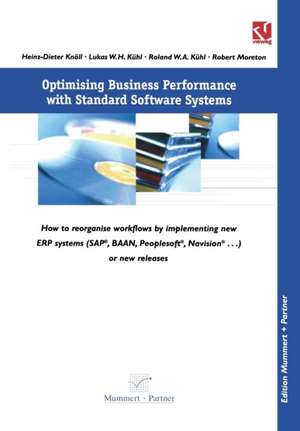Optimising Business Performance with Standard Software Systems: How to reorganise Workflows by Chance of Implementing new ERP-Systems (SAP®, BAANTM, Peoplesoft®, Navision® ...) or new Releases: XBusiness Computing
Autor Heinz-Dieter Knöll, Lukas W. H. Kühl, Roland W. A. Kühl, Robert Moretonen Limba Engleză Paperback – 6 mai 2012
Din seria XBusiness Computing
-
 Preț: 419.21 lei
Preț: 419.21 lei -
 Preț: 497.58 lei
Preț: 497.58 lei - 15%
 Preț: 473.99 lei
Preț: 473.99 lei -
 Preț: 420.40 lei
Preț: 420.40 lei - 15%
 Preț: 467.10 lei
Preț: 467.10 lei -
 Preț: 487.57 lei
Preț: 487.57 lei -
 Preț: 424.81 lei
Preț: 424.81 lei -
 Preț: 423.84 lei
Preț: 423.84 lei -
 Preț: 497.58 lei
Preț: 497.58 lei -
 Preț: 489.69 lei
Preț: 489.69 lei -
 Preț: 421.72 lei
Preț: 421.72 lei -
 Preț: 483.92 lei
Preț: 483.92 lei -
 Preț: 243.92 lei
Preț: 243.92 lei - 15%
 Preț: 514.01 lei
Preț: 514.01 lei - 15%
 Preț: 453.44 lei
Preț: 453.44 lei -
 Preț: 498.52 lei
Preț: 498.52 lei - 15%
 Preț: 503.04 lei
Preț: 503.04 lei -
 Preț: 427.71 lei
Preț: 427.71 lei - 15%
 Preț: 591.79 lei
Preț: 591.79 lei - 15%
 Preț: 497.31 lei
Preț: 497.31 lei - 15%
 Preț: 446.60 lei
Preț: 446.60 lei - 20%
 Preț: 306.24 lei
Preț: 306.24 lei -
 Preț: 356.87 lei
Preț: 356.87 lei -
 Preț: 383.50 lei
Preț: 383.50 lei -
 Preț: 496.61 lei
Preț: 496.61 lei -
 Preț: 387.46 lei
Preț: 387.46 lei
Preț: 650.86 lei
Preț vechi: 765.72 lei
-15% Nou
Puncte Express: 976
Preț estimativ în valută:
124.56€ • 129.56$ • 102.83£
124.56€ • 129.56$ • 102.83£
Carte tipărită la comandă
Livrare economică 14-28 aprilie
Preluare comenzi: 021 569.72.76
Specificații
ISBN-13: 9783322898937
ISBN-10: 3322898938
Pagini: 448
Ilustrații: XVI, 426 p. 294 illus.
Dimensiuni: 170 x 244 x 24 mm
Greutate: 0.71 kg
Ediția:Softcover reprint of the original 1st ed. 2001
Editura: Vieweg+Teubner Verlag
Colecția Vieweg+Teubner Verlag
Seria XBusiness Computing
Locul publicării:Wiesbaden, Germany
ISBN-10: 3322898938
Pagini: 448
Ilustrații: XVI, 426 p. 294 illus.
Dimensiuni: 170 x 244 x 24 mm
Greutate: 0.71 kg
Ediția:Softcover reprint of the original 1st ed. 2001
Editura: Vieweg+Teubner Verlag
Colecția Vieweg+Teubner Verlag
Seria XBusiness Computing
Locul publicării:Wiesbaden, Germany
Public țintă
ResearchCuprins
1 Preliminary Overview.- 1.1 Purpose of the Book.- 1.2 Structure of the Book.- 1.3 References and Pictograms.- 2 Standard Software: Hope and Disappointment.- 2.1 The Challenge: Why do Companies use Standard Software?.- 2.2 The missed Opportunity: Why does Standard Software often not meet a Company’s Requirements?.- 2.3 Classification of Standard Software.- 2.4 The Creative Destruction: What are the Implications of an Updated Software Release?.- 2.5 Seize the Opportunity: Positive Benefits resulting from new Software Releases.- 3 The Evolution of Business Process Orientation: From Fiction to Reality.- 3.1 The Business Process Paradigm.- 3.2 Historical Background.- 3.3 Philosophy of the Business Process Paradigm.- 3.4 The application specific context.- 4 Reveal the Opportunities: General Techniques for Business Process Optimisation.- 4.1 General Notes on BPR.- 4.2 Why Business Process Reengineering may fail.- 4.3 The Role of Business Process Optimisation (BPO).- 4.4 Object-Oriented Strategies.- 4.5 Function-Oriented Strategies.- 4.6 Resource-Oriented Strategies.- 4.7 Benchmarking.- 4.8 Reference Model based optimisation.- 4.9 Simulation.- 4.10 Algorithmic Optimisation / Approximation.- 5 Unwanted but Necessary: Popular Approaches to Business Process Modelling (BPM).- 5.1 General Considerations of Modelling and Design.- 5.2 The Benefits of Business Process Models.- 5.3 Difficulties in Modelling Business Processes.- 5.4 Properties of Process Models.- 5.5 General Techniques for the Representation of Process Flows.- 5.6 The Architecture of Integrated Information Systems.- 5.7 The Dynamic Enterprise Modeler.- 6 Beyond the Common View: Consideration of Interdisciplinary Aspects.- 6.1 Human and Social Aspects.- 6.2 Cognitive Aspects.- 6.3 Legal Aspects.- 6.4 EconomicalAspects.- 7 Viewing the Status Quo: Review of Life-Cycle Approaches.- 7.1 Structures and Properties of Life Cycle Models.- 7.2 Life-Cycle Models for Software Development.- 7.3 Implementing Process-Orientation.- 7.4 Standard Software Implementation Approaches.- 8 A Pragmatic Approach to a Semi-Process Driven Standard Software Implementation.- 8.1 General Preliminary Considerations.- 8.2 Scope of the Semi-Process Oriented Approach.- 8.3 Brief Illustration of the Project Phases.- 8.4 The Recommended Project Organisation.- 8.5 Tailoring the Approach.- 8.6 Meta Model and Key Components.- 8.7 Tool Support.- 8.8 Project Information.- 8.9 Towards a Simple Model Repository.- 8.10 Complementary Documentation.- 8.11 Success Factors and Risks.- 8.12 Phase 1: Preliminary Conception.- 8.13 Phase 2: Detailed Conception.- 8.14 Phase 3: Realisation.- 8.15 Specifics of a Release Migration Project (2nd Chance).- 8.16 Summary.
Notă biografică
· Prof. Dr. Heinz-Dieter Knöll is Professor of Software Engineering and Data Processing in Accounting, Dean, University of Applied Sciences (Fachhochschule) Nordostniedersachsen, Faculty of Business, Lüneburg, Germany, and Visiting Professor of Software Quality Assurance, University of Wolverhampton, School of Computing and Information Technology, Wolverhampton, UK, and Senior Consultant at Pros Kyberneton GmbH, Reppenstedt, Germany.
· Roland W.A. Kühl is Senior Consultant at Mummert + Partner Management Consulting AG, Diplom Wirtschaftsinformatiker, MSc in Advanced Software Technology, currently PhD Researcher at the University of Wolverhampton.
· Lukas W.H. Kühl is Senior Consultant at Mummert + Partner Management Consulting AG, Diplom Wirtschaftsinformatiker, MSc in Advanced Software Technology, currently PhD Researcher at the University of Wolverhampton.
· Prof. Dr. Robert Moreton is Professor of Computer Science, Dean and Head of Research Committee, University of Wolverhampton, School of Computing and Information Technology, Wolverhampton, UK.
· Roland W.A. Kühl is Senior Consultant at Mummert + Partner Management Consulting AG, Diplom Wirtschaftsinformatiker, MSc in Advanced Software Technology, currently PhD Researcher at the University of Wolverhampton.
· Lukas W.H. Kühl is Senior Consultant at Mummert + Partner Management Consulting AG, Diplom Wirtschaftsinformatiker, MSc in Advanced Software Technology, currently PhD Researcher at the University of Wolverhampton.
· Prof. Dr. Robert Moreton is Professor of Computer Science, Dean and Head of Research Committee, University of Wolverhampton, School of Computing and Information Technology, Wolverhampton, UK.
Caracteristici
New Standard Software Release - Second Chance











